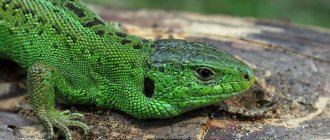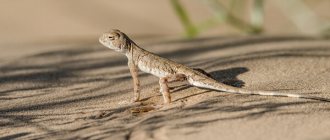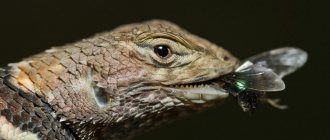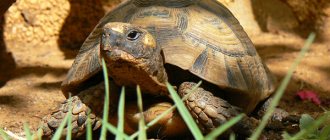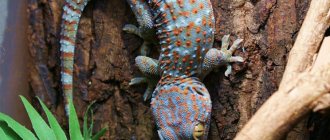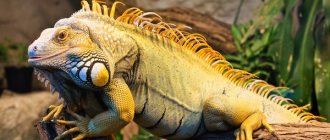The desert is a home for many reptiles, among which there is one amazing inhabitant - the round-headed reptile. This representative of agamidae lizards occupies a special place among other inhabitants of the desert, which is not surprising, because thanks to a number of features it is very difficult to confuse it even with its close relatives - other varieties of the same family.
The round-headed lizard is a small lizard from the agamidae family that has perfectly adapted to life in desert conditions.
Features of the round head
Immediately after sunrise, a curious head carefully appears from the sand: it carefully looks around and, making sure that there is no danger, the reptile climbs out. It was the roundhead that woke up - a small lizard from the agamidae family, which has perfectly adapted to life in the desert.
Appearance
Roundheads are a species of small to medium-sized lizards characterized by a short, rounded head and a short but wide, flat body, which gives this reptile a slightly awkward appearance. Another distinctive feature of the reptile is the bright coloring of the lower part of the tail, which makes it stand out against the featureless background of the desert.
So that the lizard can move deftly on quicksand desert sands, nature has endowed the toes on its paws with special processes called “sand skis”. These devices expand the area of support, thereby preventing slipping and twisting of the paws.
The weak points of the round-headed lizard are their sense of smell and hearing. The reptile's hearing organ is located in such a way that, in human understanding, would mean a complete absence of hearing.
However, the roundhead still hears, but specifically, that is, it is able to sense any vibrations in the soil.
The reptile's nostrils are also endowed with their own characteristics: the organ looks like thin slits protected by scutes, and the nasal canals are curved so that grains of sand penetrating into them immediately come out along with special protective mucus.
Scientists have not yet determined the role of the roundhead's nose in the sense of smell, but it is certain that its nostrils are of primary importance in breathing.
Underdeveloped sense of smell and hearing are fully compensated by excellent vision. Like other species of lizards, the round-headed lizard has a third eye, which, although in its infancy, nevertheless also brings benefits to the reptile. The organ is located in the back of the head and allows the reptile to distinguish the degree of illumination of the space.
- Animals of Brazil
- Tarantula spider
- 34 facts about lions
- Lynx
- 37 facts about cheetahs
- Scolopendra
The lizard is able to see a moving object at a distance of 30 meters. Thanks to such vigilance, the roundhead finds food and also escapes from enemies.
Its eyes have not only eyelashes, but also special protective shields, which allows the reptile to maintain its excellent vision even during sandstorms.
The tail of reptiles deserves a separate discussion, since it is this organ that helps them communicate with other representatives of their species. By twisting it into a spiral, waving it from side to side, or simply lifting it up, wagging only the tip in a peculiar way, they, like dogs, send each other certain signals. It is interesting that no other species of lizards are capable of wielding their tail as masterfully as the roundhead does.
Lifestyle
These reptiles are very sun-loving, and therefore lead a diurnal lifestyle. Unlike other lizards, they do not hide in the shade, but prefer to be under the scorching rays of the sun all day. Having climbed out of the sand in the morning and shook itself off, the round-headed lizard heads to the highest place in the area. Having climbed to this unique observation post, the reptile freezes in anticipation of prey. The roundhead often remains in this position for several hours, only occasionally looking around to protect itself from danger.
Seeing a threat, the reptile can disappear in the depths of the sand in a few seconds: to do this, it spreads its paws wide, falling with its whole body onto the surface, after which it begins to rapidly vibrate, causing the sand to part and absorb its body, leaving not a trace on the surface. Roundheads have plenty of enemies in nature: snakes, larger lizards (especially the gray monitor lizard), as well as birds of prey, jerboas and hedgehogs like to feast on them. The latter are the most dangerous for the reptile, since they are active during its night sleep and can reach the roundhead, which is unable to fight back, in its shelter.
Roundheads do not hide in the shade, but prefer to be under the scorching rays of the sun all day.
These lizards do not know how to crawl slowly, although they do not run the same way as other species of their relatives do: round-headed lizards move only in a straight line and do not maneuver between obstacles at all. This feature often becomes the reason that these reptiles tip over at turns or crash into the first obstacle they encounter.
As a rule, each individual lives in a certain territory, the size of which depends on many factors: the availability and supplies of food, shelters, neighbors and other needs of the “owner” of the site. Although, roundheads often lead a nomadic lifestyle, huddling in small groups and roaming the desert in search of food and shelter from enemies.
The place of residence of these reptiles sometimes changes due to the important need of their body, which is to maintain a constant body temperature: at low temperatures they choose the sunniest places, and at elevated temperatures they climb into the shade. Each roundhead lives in a certain territory, the size of which depends on many factors.
Each roundhead lives in a certain territory, the size of which depends on many factors.
At sunset, lizards go to rest for the night, which can be any secluded place: the base of a wide bush, a hole or a depression under the top layer of sand.
As for burrows, the roundhead, as a rule, digs them independently, although some individuals prefer to spend the night in the burrows of other animals.
Types of round heads
There are currently 13 species of roundheads in the CIS, of which 7 species are found in Kazakhstan. Two species are found in the Mongolian People's Republic. Other species, about 30, live in the deserts and steppes of Iran, Afghanistan, Pakistan, China, India and the Arabian Peninsula. But they have been poorly studied.
The most “famous” roundhead is the long-eared one (Phrynocephalus mystaceus). It is notable for the unusual folds of skin at the corners of its mouth, which can straighten out, giving the lizard the appearance of a monster with a terrible mouth. In addition, this is the largest roundhead (up to 20 cm including the tail), all the others are twice as small. Therefore, as well as due to other morphological features, the long-eared roundhead is sometimes classified as a separate genus. Like most desert inhabitants, the long-eared round-headed lizard is painted in sandy tones with a fine dark pattern; the lizard’s belly is white.
The long-eared roundhead is widespread in Kazakhstan. In Russia, its habitat is represented by a number of isolated populations. It is found within the foothills of Dagestan, the eastern part of Chechnya, Kalmykia, and the Astrakhan region.
The round-headed pommel (Phrynocephalus helioscopus) is widespread in Kazakhstan. It is distinguished by a particularly flat and wide body and a relatively short tail. This species has a spotted color, and the spots form a kind of cross-striped pattern. The body is usually covered with spines. There are always 2 small spots with pink and blue coloring on the neck. Some males may have more intense blue spots scattered throughout the body.
Takyr round head
The takyr roundhead is also common in Transcaucasia, southern Russia, Central Asia, Turkey, Iran, and Northwestern China.
The smallest representative of the genus is the sand roundhead (Phrynocephalus interscapularis), its body weight is only about two grams.
The roundhead (Phrynocephalus guttatus) is common in Central Asia, Kazakhstan and the northwestern part of China. In Russia, this species is found in Dagestan, Stavropol Territory and Kalmykia. The background color is sandy, but with dark transverse stripes and specks scattered along the back.
The pied roundhead (Phrynocephalus versicolor) is a common lizard in Mongolia, but in the former USSR the species is very rare, found in only a few places, most of which are located in Kazakhstan. It is included in the Red Book of this country. Its color is the same as that of the poker, but without colored spots on the neck. The motley roundhead lives on compacted substrates.
The reticulated roundhead (Phrynocephalus reticulatus) is similar to the spiny roundhead in color and size, but, like the mottled and roundhead, prefers biotypes with dense soil.
Coloring
Typically, desert lizards have a sandy coloration, which helps them hide from their enemies. The roundhead is no exception: its body is most often sand-colored with a yellowish or flesh-pink tint; the sides are brighter than the back. The head and body are decorated with camouflage colors, which are irregularly outlined dark lines. They form a complex mosaic of ovals, circles and spots. The underside of the lizard is milky white. There is a black spot on the chest (in females it is less bright than in males). The throat may have a dark marbled pattern. The end of the tail is jet black.
Habitat
The species' range is represented by a number of isolated populations, the distribution of which is entirely determined by the presence of massifs of shifting sands, but covers desert and semi-desert zones in the eastern Ciscaucasia (including foothills of Dagestan, Kalmykia and the eastern part of Chechnya), in the south of the Astrakhan region. in Kazakhstan, Central Asia, northeastern China, Iran and Afghanistan. The northern border of distribution from the Makhachkala region (Sarykum dune) in Dagestan rises to the northwest up to the Astrakhan sands inclusive, covers the entire Volga-Ural sands in the east and, rounding the Mugodzhar mountains from the south, then passes into the lower reaches of the Irgiz. To the east along the northern edge of the Muyun-Kum desert it reaches the southern coast of Balkhash and further into the Alakol basin.
The long-eared roundhead is a typical inhabitant of dunes and various types of weakly fixed sands with sparse shrub and herbaceous vegetation. The long-eared roundhead lives only in places with loose sand. These can be completely devoid of vegetation, real moving sands, in which, it seems, there is nothing living; and sand hills - dunes with single desert trees and shrubs at the base; and sandy plains with sparse shrubby and ephemeral vegetation; and deserted pastures with grass eaten away by sheep and sand crushed by hundreds of hooves. These roundheads can also be found in areas with dense soil, but only if there are real sands nearby. In suitable habitats it is a fairly common and conspicuous species. Sometimes it settles on roadsides and on the tops of strongly fixed dunes, where it forms isolated settlements.
Notes
- Ananyeva N. B., Borkin L. Ya., Darevsky I. S., Orlov N. L.
Five-language dictionary of animal names. Amphibians and reptiles. Latin, Russian, English, German, French. / under the general editorship of academician. V. E. Sokolova. - M.: Rus. lang., 1988. - P. 165. - 10,500 copies. — ISBN 5-200-00232-X. - N.B. Ananyeva, N.L. Orlov, R.G. Khalikov, I.S. Darevsky, S.A. Ryabov, A.V. Barabanov “Atlas of reptiles of Northern Eurasia (taxonomic diversity, geographic distribution and conservation status)” Zoological Institute of the Russian Academy of Sciences, St. Petersburg, p. 59
- Said-Aliev S.A. — Amphibians and reptiles of Tajikistan — Publishing House “Donish” (1979) — P. 53
- I.D. Yakovleva - Key to the reptiles of Kyrgyzstan - Frunze 1961 - P.30-32
- Description of the view on BIolib (undefined)
. Retrieved November 18, 2021.
Lizard lifestyle
Representatives of the species lead a sedentary lifestyle. Each lizard has its own feeding area, the area of which is several hundred square meters. But males do not guard their areas as strictly as the long-eared roundheads.
The habits and lifestyle of the spiny roundhead are similar to the behavior of the motley roundhead, but due to their constant residence on the sand, they have certain characteristics. The spiny roundhead often buries itself in the sand, making vibrating movements with its body. In this way they escape from their pursuers, warm themselves in cool weather and rest. In addition, these lizards can make their own burrows. At the same time, they build 2 types of burrows. Summer ones are built in the sand for a while, they quickly collapse, their length is 10-30 centimeters. Winter burrows are deeper, their length is about 80-110 centimeters.
Like many species of lizards, roundheads primarily eat ants, but in addition, their diet includes succulent parts of plants. When searching for food, they use their powerful vision, but sometimes the spiny tails are deceived and rush to the weeds that the wind blows across the sand, and only when they grab the weed do they realize that it is inedible. After the lizard spits out inedible food, it carefully cleans the labial cheeks with its tongue.
Roundheads run quickly on the sand, and they can also jump to a height of about 20 centimeters. A feature of the behavior of representatives of the species is the characteristic curling of the tail; with the help of these gestures, individuals communicate with each other. Twisted roundheads have a protective color, so they become unnoticeable in the sand not only for predators, but also for their own relatives, and the special movement of the raised tail with a contrasting black and white color on the underside allows them to find each other and communicate that this territory busy and communicate at a safe distance. The roundhead unwinds its tail very quickly, instantly dissolving and becoming invisible among the sands. Thanks to this behavior, atypical for other relatives, these lizards got their name.
Interesting facts about the reptile
After years of observing chameleons, researchers have discovered several interesting facts:
- Changing the color of a chameleon's body can happen in just 20 seconds.
- The lizard's eyes are capable of seeing in two directions at once.
- Small varieties of chameleons have a larger tongue in relation to their body than their larger relatives.
- Shooting, the chameleon's tongue is able to catch the victim in 0.07 seconds.
- Each chameleon foot is equipped with 5 toes, grouped into sections of 2 or 3 toes. This gives the lizard's paws a resemblance to forceps. The limbs of the reptile are very well adapted to moving through trees.
- Male chameleons have a more striking appearance. Many wear “decorations” on their faces and heads in the form of processes, ridges or protrusions.
- Chameleons, like snakes, do not have ears, middle or outer, and therefore these lizards hear poorly.
- Chameleons are able to see the surrounding reality in normal and ultraviolet light.
The American chameleon is in fact a small lizard of the iguana family. Exotic chameleons are lizards that are popular among both naturalists and potential pet owners. A distinctive feature of these reptiles is the ability to change the color of their skin. Some types of chameleons are suitable for keeping at home.
Watch this video on YouTube
Nutrition
The diet consists mainly of various insects. Preference is given to ants, flies and butterflies. Sometimes roundheads feed on small lizards and arachnids. Adults eat with appetite the flowers of plants that occasionally appear in the desert.
The reptile, noticing its prey, immediately rushes towards it and grabs it with its mouth as it runs. She licks ants with her sticky tongue. A hunting trophy that is too large breaks into small pieces and slowly swallows them. While eating, the predator remains alert and sensitively reacts to what is happening around.
Having finished its meal, the long-eared roundhead returns to its observation post. She receives the necessary moisture from food. When rare rains fall, the reptile does not hide, but, on the contrary, exposes its body to the raindrops with obvious pleasure.
Keeping at home
Roundheads are very funny creatures, and therefore increasingly attract lovers of home reptile breeding. However, in their desire to have a new pet, many exotic lovers forget to familiarize themselves with the rules of keeping, which ultimately leads to the rapid death of the lizard.
Experts generally do not recommend relocating this reptile to artificial conditions, since it tolerates such experiments extremely poorly.
The main disadvantages of keeping a roundhead as a pet:
- complex care, including constant monitoring of temperature and humidity in the terrarium;
- expensive equipment;
- difficulties with feeding the reptile and providing it with access to water.
Buying and bringing a new exotic resident into your home is not a difficult task, but it is much more difficult to provide such a pet with all the conditions for its full life. And, most importantly, life in captivity deprives any animal of the main value given to it by nature - freedom, and therefore it is worth thinking very carefully before deliberately dooming a living creature to lifelong imprisonment and, probably, quick death.
Video
Sources
- https://rybki.guru/reptilii/kruglogolovka.htmlhttps://dront.ru/archive/di-zajsanskaya-kruglogolovka-phrynocephalus-melanurus/https://www.redbookkz.info/species.php?num=117&lang= ruhttps://zooclub.ru/rept/vidy/71.shtmlhttps://www.rus-nature.ru/13rept/035.htm
Reproduction
Animals reach sexual maturity in the first year of life. During the mating season, the male will definitely rush from his observation post when the female appears. Its behavior in this case is similar to that in relation to its opponent - the same curling of the tail, opening of the mouth, throwing away sand with its paws. But the male is not afraid of an attack from the female and turns to her not sideways, but with his muzzle. If the female is not inclined to accept courtship, she runs away. When the male prevents her from doing this, she simply rolls over onto her back. This specific behavior of females of all species of roundheads who are not ready for mating is intended to stop the mating claims of males. In extreme cases, the female can simply bury herself in the sand right in front of the “suitor’s” nose. The female receiving courtship demonstrates a posture of pacifying, submissive behavior, pressing her whole body to the sand.
Mating continues from the second half of April until the beginning of July. The first egg laying occurs in mid-May - mid or late June; the second - in the second half of July. There are 2 - 6 eggs in a clutch, measuring 15 - 22 x 25 - 31 mm. The clutch size depends on the size and age of the females. Young lizards emerge from eggs starting in late July, with mass hatching beginning in mid-August. The dimensions of newborns are 30 - 40 mm. Sexual maturity occurs at the end of the second year of life. The young usually settle close to each other in the areas where the clutches are located. Their individual sites are often located on the territory of adult and subadult individuals. Young of the year practically do not move away from their burrows (no more than 1.5 - 10 m).
Video
Lifestyle and behavior
In June-July, the long-eared roundhead has two periods of activity - morning and evening. After wintering, this lizard appears in late March - early April. During warm winters in Central Asia, single individuals are active as early as the end of February. In autumn, the long-eared roundhead hides in wintering shelters in early October. Lizards make shelters in inter-dune depressions or on the slopes of dunes, where they dig straight burrows, up to 70-90 cm long, ending in a slight expansion in a layer of moistened sand. In summer, as a rule, only young individuals live in them, while adults take shelter at night, in bad weather, or in case of danger, plunging into the sand with quick oscillatory movements of the body. At the same time, the roundhead pushes the sand under itself, which, thanks to the same movements, is picked up by the spiny scales on the sides and, falling onto its back, quickly covers the lizard.
In cases where it is impossible to hide from pursuit, the long-eared roundhead takes a characteristic frightening pose in which, spreading its hind legs wide apart and spreading, it raises the front part of its body and opens its mouth wide; the mucous membrane of the inner lining of the mouth, as well as the straightened skin folds in the corners of the mouth, acquire a red color; the lizard hisses, quickly curls and unwinds its tail, and usually jumps towards the enemy. These lizards can be very aggressive. Cases of aggression occur both between males when defending territory and during the mating season, and between individuals of different sexes and ages.
